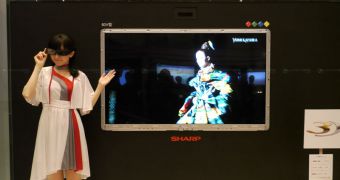Sharp Corporation is known for making its various LCD displays as sharp as possible, color-wise, that is, and the upcoming 3D TV (or TVs) will, of course, do its (or their) best to stay sharp as well.
Unlike other displays, however, this one will take advantage of FRED in order to achieve, according to the monitor maker, “the industry’s highest brightness with extremely low crosstalk” and “brighter, more vivid colors thanks to higher light transmission efficiency through the panel and a wider color gamut.” This is possible because FRED is able to bring Yellow into the primary color spectrum of the monitor.
FRED is the short name that Sharp gave to its four-primary-color technology, which goes beyond the conventional three-color video output method generally used. Basically, yellow is added into the mix (RGBY), increasing the maximum number of colors.
Of course, this technology isn't all that new, but what is unprecedented is its use in the making of a 3D display, especially one that has the added advantage of a 1.8 higher brightness otherwise not achievable. Sharp also plans to implement its side-mount scanning LED backlight technology, which reduces crosstalk, and the UVA technology (Ultraviolet-induced multi-domain Vertical Alignment).
“The newly developed 3D LCD by Sharp offers a radical new solution to the above problems by combining four of Sharp’s unique, one-of-a-kind LCD technologies, including UVA technology, Sharp’s core technology for LCD TV panels, four-primary-color technology, FRED technology, and side-mount scanning LED backlight technology,” the official press release explains. “This LCD is optimized for 3D TV, as screen brightness when displaying 3D images is 1.8 times higher than that of the conventional displays, and crosstalk is extremely low. Sharp’s four-primary-color technology utilizes four primary colors, adding Y (yellow) to the three conventional primary colors of R (red), G (green), and B (blue). This technology contributes to brighter, more vivid colors thanks to higher light transmission efficiency through the panel and a wider color gamut (range of colors that can be reproduced), which had been difficult to attain on conventional three primary color displays.”
Most markets, including Europe and North America, will have to wait until later this year for Sharp's 3D TVs. In summer, they will only be launched in Japan.

 14 DAY TRIAL //
14 DAY TRIAL //